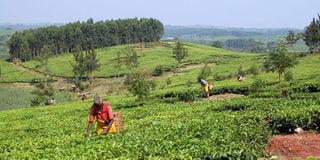Farmers demand tea regulatory authority

On the farm. Farmers harvest tea leaves at Mpanga Tea Farm in Kabarole District on Tuesday. PHOTO BY ALEX ASHABA
What you need to know:
- Annually, Uganda earns about $90-100 million from tea and the crop is one of the country’s traditional exports. The industry employs over 62,000 people and supporting more than 500,000 dependents in Uganda.
Tea is largely grown along the Lake Victoria crescent, the lower slopes of the Rwenzori Mountain and above the western rift valley.
KYENJOJO/KABAROLE. Tea farmers in Tooro Sub-region are lobbying government to institute an independent tea regulatory authority to check tea standards.
The authority, if instituted, would also advocate for better regulatory policies that would protect tea farmers from exploitation by middlemen.
Tooro region is the land of tea, commonly referred to as the ‘Green Gold’, one of the most delicious and sought after teas in the world.
Tea is grown in the deep, rich and well-watered soils that are unique to the region.
Farmers say middle men pay them about Shs250 per kilo of green leaf, which is lower than what factories pay (between Shs400 and Shs600) after two weeks. This, the farmers say, has compromised the quality of tea since some farmers sell substandard and immature tea leaves to earn quick cash.
Mr John Kyomya, a tea farmer in Kyenjojo District, says: “We want government to help us by forming a tea regulatory authority so that the quality of tea supplied to factories is not compromised mainly by the middle men.”
He adds: “Because farmers want quick cash, they end up picking poor quality tea with grass and other shrubs and sell it to middlemen.”
The international tea standards require a farmer to supply tea leaves while still fresh and without other plants.
The farmers say although middlemen pay in time, they are cheated because they buy from them cheaply yet they sell the tea exorbitantly.
President Museveni in 2016 said his government had set interventions to improve the market of the Ugandan tea.
Among the interventions, he said, he had talked to Arab countries to buy Ugandan tea and promised to extend subsidies like fertilisers to farmers.
In Tooro and in the whole of western Uganda, at least 200,000 people earn their living by plucking the green leaves.
They earn between Shs10,000 and Shs20,000 each on average per day depending on the kilos one has plucked.
Farmers and companies pay between Shs100 to Shs120 per kilo of plucked green tea per day from morning up to midday.
The temperate climate allows tea to flourish from the lush plantations as it is harvested throughout the year.
The tea from the farm is of good quality, has a soothing and pleasant taste and is of a rich brown colour.
According to Mr Kasoro Atwooki, a tea farmer and a board member of Mabale Growers’ Tea Factory Ltd in Kyenjojo District, tea is the majority export from Tooro Sub-region, followed by coffee.
All this has attracted investors, who have set up six tea factories in Kabarole and four in Kyenjojo districts, while others have set up tea nursery beds as a business to supply tea plantlets to farmers in the western region.
Mabale Tea Factory, one of the four factories in Kyenjojo District is an outgrowers-based plant. It is owned by about 3,600 farmers, who are shareholders following the privatisation of public enterprises in Uganda in the 1990s.
About 6,000 tea farmers in Kyenjojo and Kabarole districts, who earn between Shs2 million and Shs3 million monthly depending on the size of their plantations, supply green tea to the factory, according to Mr Kasoro.
“Each farmer employs more than five workers and each household in these districts has more than 12 people,” he adds.
Overproduction
According to Ms Sylvia Rwabwogo, a tea farmer in Kyenjojo, they produce more tea than what the factories around can consume.
Without any tea estates of its own, Mabale Tea Factory produces three million kilogrammes of tea in two months, which is about 10 per cent of Uganda’s annual tea export, to the world market.
Speaking to tea farmers at Mabale Tea Factory recently, Col John Anywar, the director of tea, coffee and cocoa under the Operation Wealth Creation programme assured the farmers and processors that he would table their views to his boss, Gen Salim Saleh.
Annually, Uganda earns about $90-100 million from tea and the crop is one of the country’s traditional exports. The industry employs over 62,000 people and supporting more than 500,000 dependents in Uganda.
Tea is largely grown along the Lake Victoria crescent, the lower slopes of the Rwenzori Mountain and above the western rift valley.
Tea in Uganda
Introduction. Tea was first introduced in Uganda in 1909, but commercial cultivation didn’t begin until the late 1920’s.
Decline. But in the 1970s, tea productions nearly stopped due to war, economic upheaval, and the government’s expulsion of many Asian-owned tea estate farmers.
The return. In the early 1980s, British businessman and entrepreneur, Mitchell Cotts returned to Uganda and formed the Toro and Mityana Tea Co.(Tametco), a joint venture with the government.
This move increased tea production from 1,700 tonens in 1981 to 5,600 tonnes in 1985 yet production was far less than the peak amount of 22,000 tons in 1974, and even began to decline again slightly after 1985.
Consumption. In the world today, tea stands out to be one among the most consumed popular beverages.
Blessed Uganda. With its temperate climate and rich soil, Uganda grows some of the world’s top quality tea.




